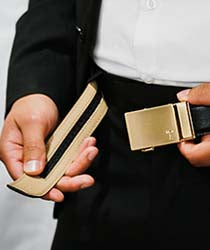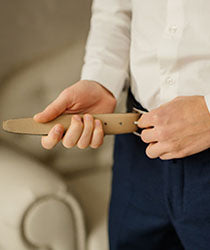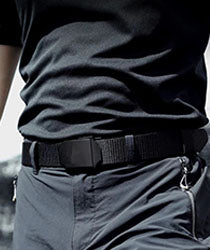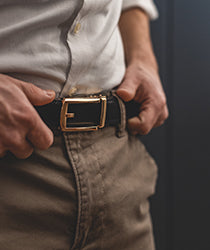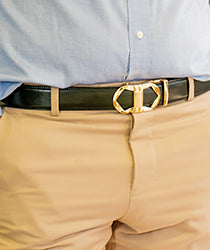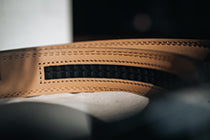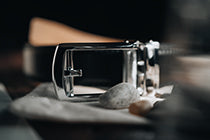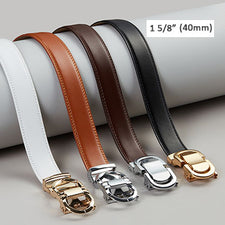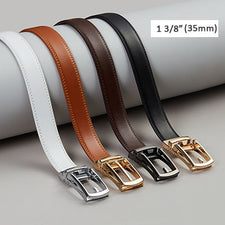Belts have played a vital role in men's fashion for centuries, serving not only as a functional accessory to keep pants in place but also as a stylish addition to any outfit. The market offers an extensive range of belts in various materials, colors, and styles, making it crucial to select the perfect belt that harmonizes with your overall attire.
I. Choosing the Right Belt
Before we dive into the specific ways of wearing belts with different clothing items, let's discuss the fundamental aspects of choosing the right belt:
1. Determining the Correct Belt Size
To ensure a comfortable and proper fit, it's crucial to determine your belt size accurately. Most belts are sized based on the length from the buckle's end to the middle hole. Measure your waist size with a measuring tape and select a belt size that corresponds to your waist measurement. If you're unsure, it's always better to go for a slightly longer belt and make adjustments accordingly.
2. Selecting the Appropriate Belt Material
Belts come in various materials, including leather, fabric, and synthetic options. Leather belts are timeless classics that offer durability and a sophisticated look. Fabric belts are more casual and can add a touch of color or pattern to your outfit. Synthetic belts are often budget-friendly and come in a wide range of styles.
3. Considering the Belt Buckle Style
Belt buckles come in different shapes, sizes, and finishes. It's important to choose a buckle that matches the occasion and complements your overall style. Classic and minimalist buckles are suitable for formal occasions, while more decorative buckles can add flair to casual outfits.
Now that we have a basic understanding of belt selection let's explore how to wear belts with specific clothing items.
II. How to Wear a Belt with Jeans
Jeans are a wardrobe staple for many men, and pairing them with the right belt can elevate your casual look. Here are some guidelines to follow when wearing a belt with jeans:
1. Casual Belt Options for Jeans
When it comes to choosing a belt for jeans, you have several options. A leather belt with a slightly wider width is a versatile choice that complements most jean styles. For a more rugged and casual look, consider a distressed leather or woven fabric belt. These options add texture and personality to your outfit.
2. Matching Belt Color with Shoes
To achieve a cohesive look, it's important to match your belt color with your shoes. For jeans, brown or black belts are the most common choices. If you're wearing brown shoes, opt for a belt in a similar shade of brown. Similarly, pair black shoes with a black belt. This color coordination creates a harmonious and well-put-together appearance.
3. Tucking in or Leaving the Shirt Untucked
When wearing a belt with jeans, the choice of tucking in your shirt or leaving it untucked depends on the occasion and your personal style preference. Tucking in your shirt gives a neater and more formal look, while leaving it untucked creates a relaxed and casual vibe. Experiment with both styles to see which one suits your outfit and occasion best.
IIV. Pairing a Belt with Dress Pants
Dress pants demand a more formal and polished appearance. Here's how you can pair a belt with dress pants:
1. Formal Belt Options for Dress Pants
Dress pants require a more refined belt choice. Opt for a narrow and sleek leather belt in black or brown. Avoid belts with excessive embellishments or overly large buckles, as they can distract from the overall elegance of your outfit.
2. Coordinating the Belt with the Shoe Color and Style
When wearing dress pants, it's essential to coordinate your belt color with your shoe color. If you're wearing black shoes, choose a black belt. For brown shoes, go with a brown belt that matches the shoe shade. Additionally, ensure that the shoe style aligns with the formality of the dress pants.
3. Ensuring the Belt Fits Properly
Proper fit is crucial when wearing a belt with dress pants. The belt should sit comfortably around your waist, without being too tight or too loose. Aim for a fit that allows you to fasten the belt using one of the middle holes. This ensures a polished appearance and avoids any discomfort caused by an ill-fitting belt.
IV. Styling a Belt with Shorts
Belts can also be a stylish addition to your shorts outfit. Here's how to wear a belt with shorts:
1. Choosing a Suitable Belt for Shorts
When selecting a belt for shorts, consider a casual option that matches the relaxed nature of the garment. Canvas belts, braided belts, or colorful fabric belts can add a touch of personality and provide a focal point to your shorts ensemble.
2. Optimal Belt Length for Shorts
The belt length for shorts should be slightly shorter than what you would wear with pants. Aim for a length that allows for a small tail of the belt to extend past the buckle when fastened. Avoid excessively long belts that can look disproportionate and disrupt the balance of your outfit.
3. Creating a Balanced and Stylish Look
When wearing a belt with shorts, it's essential to create a balanced and cohesive look. Pair your belt with a complementing shirt or polo, and consider matching the belt color with other elements of your outfit, such as your shoes or accessories. This attention to detail adds a sense of thoughtfulness to your overall style.
V. Maintaining and Caring for Belts
To keep your belts in excellent condition and ensure their longevity, follow these maintenance and care tips:
1. Proper Belt Storage to Maintain Its Shape
When not in use, store your belts in a cool and dry place. Hanging them on a belt rack or laying them flat in a drawer helps maintain their shape. Avoid storing them in tight spaces or folding them, as this can lead to creasing or distortion.
2. Cleaning Different Types of Belts
The cleaning method for your belt depends on its material. For leather belts, use a leather cleaner and conditioner to remove dirt and keep the leather moisturized. Fabric belts can be spot cleaned with a mild detergent and warm water. Be sure to follow the manufacturer's instructions for cleaning synthetic belts.
3. Dealing with Belt Wear and Tear
Over time, belts may experience wear and tear, such as scratches, fraying edges, or loose threads. Regularly inspect your belts for any signs of damage and address them promptly. Consider getting professional repairs done for significant issues or replace the belt if necessary.
VI. Belt Accessories and Complementary Items
To enhance your belt-wearing experience, consider incorporating belt accessories and complementary items:
1. Adding Belt Loops to Pants without Them
If your pants lack belt loops, you can attach belt loops using clip-on belt loops or have a tailor add permanent loops to the pants. Belt loops help keep your belt in place and prevent it from sliding or shifting throughout the day.
2. Using Belt Anchors to Keep the Belt in Place
Belt anchors or shirt stays are small accessories that attach your shirt to the belt, ensuring it stays neatly tucked in. These handy tools are especially useful when wearing a belt with dress pants, as they maintain a polished and streamlined appearance.
3. Belt Enhancers like Belt Bags and Suspenders
For those who want to take their belt game to the next level, consider belt enhancers like belt bags or suspenders. Belt bags, also known as fanny packs, provide a functional and trendy way to carry small essentials while adding a fashion-forward touch. Suspenders can be a stylish alternative to a belt, particularly when aiming for a vintage or retro-inspired look.
VII. Fashion Tips and Trends
To stay on top of the latest belt fashion trends and elevate your style, consider the following tips:
1. Incorporating Patterns and Textures in Belts
Don't be afraid to experiment with belts that feature patterns or textures. Animal prints, woven designs, or embossed textures can add a unique and eye-catching element to your outfit. Pair patterned belts with solid-colored clothing to maintain a balanced and cohesive look.
2. Experimenting with Belt Colors and Styles
While classic black and brown belts are timeless options, don't hesitate to explore different colors and styles. Navy blue, burgundy, or even metallic belts can inject personality and freshness into your ensemble. Just ensure that the belt complements the overall color palette and style of your outfit.
3. Following Current Belt Trends
Fashion trends evolve, and belts are no exception. Keep an eye on the latest belt trends by browsing fashion magazines, blogs, or following style influencers. However, remember that personal style and comfort should always take precedence over fleeting trends. Choose belts that align with your individual taste and enhance your overall look.
VIII. Conclusion
Mastering the art of wearing a men's belt with jeans, dress pants, and shorts can significantly elevate your style game. By choosing the right belt, coordinating it with your outfit, and paying attention to the fit and details, you can achieve a polished and put-together appearance for any occasion. Remember to consider your personal style, comfort, and the formality of the event when selecting belts, and don't hesitate to experiment with different colors, materials, and styles to showcase your unique fashion sensibility.
IX. FAQs
-
Can I wear a black belt with brown shoes? Yes, it is generally advised to match the color of your belt with your shoes. However, some fashion rules are meant to be broken. A black belt with brown shoes can create a stylish contrast if done purposefully and with confidence.
-
How do I determine my belt size? To determine your belt size, measure your waist using a measuring tape. Add a few inches to this measurement to account for the overlap and buckle. Alternatively, you can use an existing belt that fits well and measure from the buckle's end to the hole you typically use.
-
Should I match my belt color with my watch strap? Matching your belt color with your watch strap is not a strict rule. However, it can create a harmonious and coordinated look. Consider the overall aesthetic of your outfit and the desired level of coordination when deciding whether to match the belt color with your watch strap.
-
Are there specific belts for formal occasions? Yes, for formal occasions, it's best to opt for narrow and sleek leather belts in classic colors such as black or brown. Avoid belts with excessive embellishments or flashy buckles, as they can detract from the formal elegance of your attire.
-
Can I wear a belt with shorts? Absolutely! Wearing a belt with shorts can add a touch of style and provide a focal point to your outfit. Opt for a casual belt that complements the relaxed nature of shorts and consider coordinating the belt color with other elements of your ensemble for a cohesive look.

